

Python gnupg (GPG) example. Python gnupg (GPG) example python-gnupg is a Python package for encrypting and decrypting strings or files using GNU Privacy Guard (GnuPG or GPG).
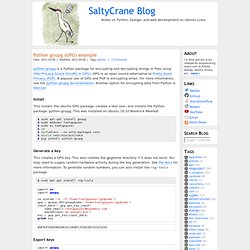
GPG is an open source alternative to Pretty Good Privacy (PGP). A popular use of GPG and PGP is encrypting email. Python - BeautifulSoup, where are you putting my HTML. 19.7. xml.etree.ElementTree — The ElementTree XML API — Python v2.7.4 documentation. The Element type is a flexible container object, designed to store hierarchical data structures in memory.

The type can be described as a cross between a list and a dictionary. To create an element instance, use the Element constructor or the SubElement() factory function. The ElementTree class can be used to wrap an element structure, and convert it from and to XML. 19.9. xml.dom.minidom — Minimal DOM implementation — Python v2.7.4 documentation. New in version 2.0.
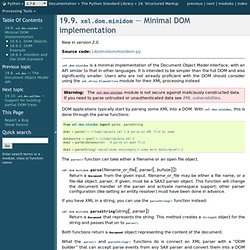
Source code: Lib/xml/dom/minidom.py xml.dom.minidom is a minimal implementation of the Document Object Model interface, with an API similar to that in other languages. It is intended to be simpler than the full DOM and also significantly smaller. Users who are not already proficient with the DOM should consider using the xml.etree.ElementTree module for their XML processing instead DOM applications typically start by parsing some XML into a DOM. From xml.dom.minidom import parse, parseString dom1 = parse('c:\\temp\\mydata.xml') # parse an XML file by name datasource = open('c:\\temp\\mydata.xml')dom2 = parse(datasource) # parse an open file dom3 = parseString('<myxml>Some data<empty/> some more data</myxml>')
Python - Write xml utf-8 file with utf-8 data with ElementTree. Django - Python UTF-8 conversion problem. Show escaped string as Unicode in Python. Unicode/UTF-8-character table. Unicode "table of character" implementation in python. Nicolas Pontoizeau schrieb: I am handling a mixed languages text file encoded in UTF-8.
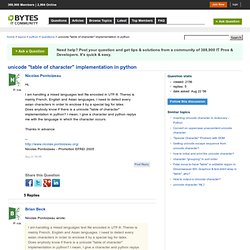
Theres is mainly French, English and Asian languages. I need to detect every asian characters in order to enclose it by a special tag for latex. Does anybody know if there is a unicode "table of character" implementation in python? I mean, I give a character and python replys me with the language in which the character occurs. This is a bit unspecific, so likely, nothing that already exists will be completely correct for your needs. In any case, somebody pointed you to the Unicode code blocks. Notice that some scripts are used both in Asia and elsewhere, e.g. Regards, Martin. Unicode/UTF-8-character table - starting from code position 0080. How do I convert a unicode to a string at the Python level. Python "denormalize" unicode combining characters. Osx - Precompose Unicode Character Sequences in Python. 7.9. unicodedata — Unicode Database. Return the normal form form for the Unicode string unistr.
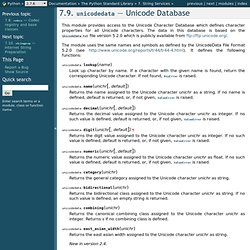
Valid values for form are ‘NFC’, ‘NFKC’, ‘NFD’, and ‘NFKD’. The Unicode standard defines various normalization forms of a Unicode string, based on the definition of canonical equivalence and compatibility equivalence. In Unicode, several characters can be expressed in various way. For example, the character U+00C7 (LATIN CAPITAL LETTER C WITH CEDILLA) can also be expressed as the sequence U+0043 (LATIN CAPITAL LETTER C) U+0327 (COMBINING CEDILLA). For each character, there are two normal forms: normal form C and normal form D. In addition to these two forms, there are two additional normal forms based on compatibility equivalence. The normal form KD (NFKD) will apply the compatibility decomposition, i.e. replace all compatibility characters with their equivalents.
Even if two unicode strings are normalized and look the same to a human reader, if one has combining characters and the other doesn’t, they may not compare equal. Unicode In Python, Completely Demystified. UnicodeDecodeError: 'ascii' codec can't decode byte 0xc4 in position 10: ordinal not in range(128) Never seen this exception? Seen it and sort of fixed it? This is a confusing errorIf you've never seen this before but want to write Python code, this talk is for youIf you've seen this before and have no idea how to solve it, this talk is for youThis is a really confusing error if you don't know what Python is trying to do for you; this talk aims to clarify The truth about strings in PythonThe magic of UnicodeHow to work with Unicode in Python 2fundamental conceptexample codeGlimpse at Unicode in Python 3Ask lots of questionsCorrections?
Handle non-English languagesuse 3rd party modulesaccept arbitrary text inputyou will love Unicodeyou will hate Unicode [form input] => [Python] => [HTML] accepts input as textwrites text to an html file [read from DB] => [Python] => [write to DB] accepts input as textwrites text to the database. Encoding detection in Python, use the chardet library or not. Encoding issue inserting into MongoDB with Python. Unicode HOWTO. This HOWTO discusses Python 2.x’s support for Unicode, and explains various problems that people commonly encounter when trying to work with Unicode.
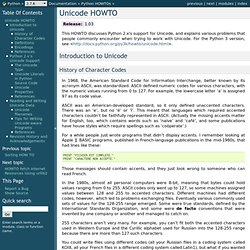
For the Python 3 version, see < Introduction to Unicode History of Character Codes In 1968, the American Standard Code for Information Interchange, better known by its acronym ASCII, was standardized. ASCII defined numeric codes for various characters, with the numeric values running from 0 to 127. ASCII was an American-developed standard, so it only defined unaccented characters. For a while people just wrote programs that didn’t display accents.
Those messages should contain accents, and they just look wrong to someone who can read French. In the 1980s, almost all personal computers were 8-bit, meaning that bytes could hold values ranging from 0 to 255. 255 characters aren’t very many. There’s a related ISO standard, ISO 10646. Ironpython - what does leading '\x' mean in a python string '\xaa' Working with utf-8 encoding in python source. Handling Accented Characters With Python Regular Expressions. Python - UnicodeDecodeError: 'utf8' codec can't decode byte 0x9c. What is the best way to remove accents in a python unicode string. Regex 2013-02-23. Unidecode 0.04.12. ASCII transliterations of Unicode text It often happens that you have text data in Unicode, but you need to represent it in ASCII.
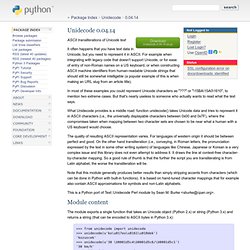
For example when integrating with legacy code that doesn't support Unicode, or for ease of entry of non-Roman names on a US keyboard, or when constructing ASCII machine identifiers from human-readable Unicode strings that should still be somewhat intelligeble (a popular example of this is when making an URL slug from an article title).
In most of these examples you could represent Unicode characters as "??? " or "\15BA\15A0\1610", to mention two extreme cases. But that's nearly useless to someone who actually wants to read what the text says. The quality of resulting ASCII representation varies. Regex - matching unicode characters in python regular expressions. Handling non-standard American English Characters and Symbols in a CSV, using Python. Character encoding - Python: Converting from ISO-8859-1/latin1 to UTF-8.